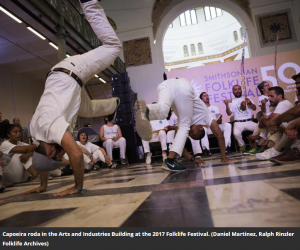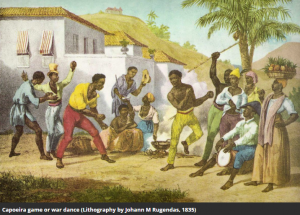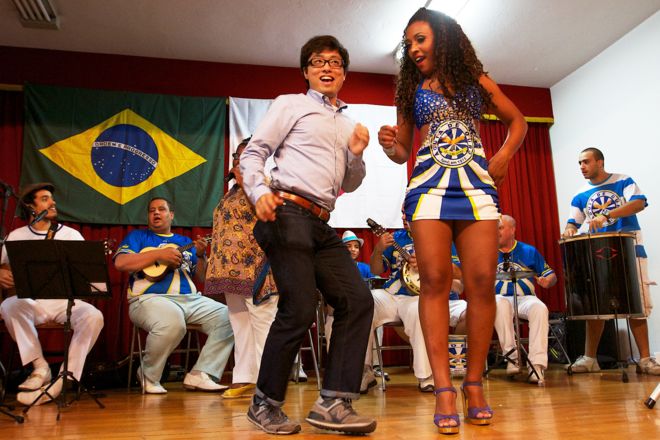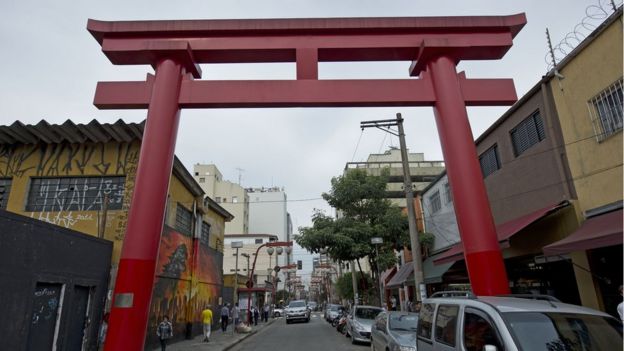Capoeira, an Afro-Brazilian martial art, played a central role in the Smithsonian Folklife Festival in 2017. Through combining musical elements and dancing skills, Capoeira practitioners compose various choreographic techniques that are comprised of constant flows of offensive and defensive movements between two combatants who explore and exploit their opponent’s strengths and weaknesses. After the exchange of movements, they patiently seek the perfect moment to strike a decisive blow. According to the Smithsonian Magazine, an online platform that publishes academic research and studies conducted by the Smithsonian institution, Capoeira contains a rich background that emphasizes both its cultural and historical values. Today, fans perceive Capoeira as an art form, rather than a traditional combat practice. However, Capoeira has a deep historical root that traces back to the colonial period.
Enslaved Africans in Brazil developed Capoeira to resist European oppression. According to an article published by the Smithsonian magazine, historians surmise that Capoeira originated from quilombos, small communities organized by escaped African slaves and their descendants. The article argues Capoeira emerged as a defensive tool against the Portuguese and was under the influence of African cultural system within quilombos. In the mid-1800s, the Paraguayan War fueled a massive influx of slave population to urban areas in which the African immigrants utilized Capoeira as a mean for protection and survival. However, Capoeira conveyed both aggressive and inoffensive images in the twentieth century. Professions such as mercenaries and bodyguards that require physical protection services trained in Capoeira, whereas urban residents performed Capoeira with musical instruments at bars. During the 1930s, Capoeira underwent various transitions. For example, Master Bimba institutionalized Capoeira as an educational discipline through legitimizing Capoeira in the form of self-defense and athletics, which later contributed to presenting Capoeira as an official cultural practice in Brazil that emphasized “paramount fighting techniques but [an] innovative [and] spectacular visual show.”
Capoeira continued to evolve as an art form during the late twentieth century. According to the Smithsonian magazine, Capoeira experienced a major success in expanding its presence across the nation. In 1964, Master Acordeon promoted Capoeira through touring, hosting seminars, and teaching in local schools of Brazil. His influence later spread throughout the world. He founded the World Capoeira Association, an organization that promoted Capoeira through “workshops, educational trips, publications, and codifying a body of rules for the understanding and respect for the history, rituals, traditions, and philosophy.” Acordeon further propagated Capoeira across Brazil, the Caribbean, and Europe. Moreover, Capoeira was initially introduced to Americans in 1975, where educational institutions such as Columbia, Yale, Harvard, and New York universities implemented Capoeira as their program. In 1990, two Capoeira masters launched an institution that taught Capoeira in United States; their commitment was recognized with the National Endowment for the Arts National Heritage Fellowship. Although many Capoeira masters in Brazil disapproved of the sport’s globalization, Capoeira became an official national sport in 1972.
Capoeira possesses both artistic and cultural values. Capoeira practitioners redefined the sport as an aesthetic work in the twentieth century. For example, Master Joao Grande believes “Capoeira is nature.” His inspirations in creating techniques have derived from observing nature. However, Tekken, a Japanese video game franchise, interprets Capoeira as a combative tool through applying Capoeira techniques in combat. Eddy Gordo, an affluent Brazilian male fighter, plays an important role in Tekken. After his father’s death, Gordo was wrongfully imprisoned, which motivated him to train Capoeira for taking revenge on his father’s killer. Although his ethnicity was not specified in his biography, Tekken designed him as a Brazilian who wears a green and yellow colored outfit, speaks Portuguese, and has a dark skin tone. Recent updates within the game added new features to Gordo’s outfit such as a tiger coat. Furthermore, Gordo manages an orphanage in Brazil in which the children view him as a hero with indestructible combat skills. Overall, Gordo’s characteristics resemble popular representation of Brazil as well as Capoeira. The character requires a consistent control of chain commands to invoke attacks and his skills show a constant flow of various physical movements, which reflects the fighting structure and style in Capoeira. Without the musical components, Tekken portrayed Capoeira as a combat weapon.
Capoeira serves as significant historical evidence of how African slaves in Brazil reacted against European oppression during the colonial period. Stuart Schwartz, a history professor at Yale University, argues various forms of resistance existed throughout the colonial era, in which palmares functioned as a social protection for African slaves. According to the Smithsonian magazine, the African slaves considered Capoeira as a defensive tool to protect themselves from the European brutality, and they practiced Capoeira to break “the bonds of slavery in both physically and mentally.” Furthermore, although the European perspectives categorized the slave resistance as unlawful, the core identity of Capoeira conveys “cleanliness and articulation” that reflect African slaves’ “burning desire for freedom.” Today, the key ideology behind Capoeira transformed yet the sport continues to remain as a representative cultural figure in Afro-Brazilian heritage. For example, in the PBS series “Black in Latin America,” a Brazilian Capoeira master shares that he supervises Capoeira sessions for the youths in Salvador to discipline their minds and prevent young Brazilians being involved in potential criminal activities.
The Smithsonian article argues Capoeira “is a result of the phenomenon of people migrating to new lands…Capoeira was conceived in Africa and born in Brazil.” In class, we discussed the cultural diversity in Brazil. Numerous immigrants with various ethnic backgrounds constitute the Brazilian cultural identity of which Capoeira serves as a popular component. Similarly, Brazilian jiu-jitsu is another example. In 1909, Geo Omori, a Japanese immigrant in Brazil, founded the first jiu-jitsu school. Compared to Capoeira, both sports focus on building individual’s character and physical fitness. In the early 1990s, Brazilian jiu-jitsu became a nationally prominent sport with many practitioners in Brazil and international tournaments. In a broader historical theme, Capoeira alongside Brazilian jiu-jitsu indicates the cultural diversity in Brazil and suggests that the readers fully take account of contextualizing this aspect in understanding the Brazilian cultural identity.
Works Cited
Brazil. Directed by Ricardo Pollack. PBS, 2011. Accessed February 6, 2018.
“Brazilian jiu-jitsu.” Wikipedia. February 05, 2018. Accessed February 07, 2018. https://en.wikipedia.org/wiki/Brazilian_jiu-jitsu.
“Eddy Gordo.” Tekken Wiki. Accessed February 07, 2018. http://tekken.wikia.com/wiki/Eddy_Gordo.
Goncalves-Borrega, Juan . “How Brazilian Capoeira Evolved From a Martial Art to an International Dance Craze.” Smithsonian.com. September 21, 2017. Accessed February 07, 2018. https://www.smithsonianmag.com/smithsonian-institution/capoeira-occult-martial-art-international-dance-180964924/.
Schwartz, Stuart B. Slaves, peasants, and rebels: reconsidering Brazilian slavery. Vol. 82. University of Illinois Press, 1996.








 (Forte)
(Forte)











